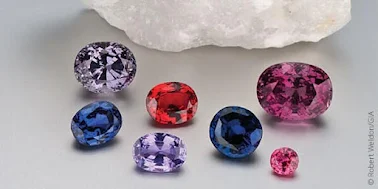Spinel is finally getting the spotlight it deserves. Once mistaken for ruby and long overlooked, this vibrant gemstone is now being hailed as one of the most precious stones in the world. With its rainbow of natural colors, brilliant clarity, and centuries of royal history, spinel has become a favorite among gem collectors, jewelers, and enthusiasts. But what makes it so special? Let’s dive into the remarkable story of spinel—a gem that’s as scientifically fascinating as it is visually stunning.
A Gem with Royal Roots
Spinel has a long and storied history dating back over 2,000 years. The earliest documented spinels were found in Afghanistan around 100 B.C. Throughout history, it was prized by royalty and collectors alike—often mistaken for ruby due to their similar color and geological origin.
One of the most famous examples is the Black Prince’s Ruby in the British Crown Jewels. Despite its name, this stone is actually a red spinel. Such confusion was common for centuries, as spinel and ruby often occur together in the same mines—particularly in regions like Sri Lanka, Myanmar (Burma), and Vietnam.
It wasn’t until the late 18th century that scientists formally identified spinel as a separate mineral from corundum (the family that includes rubies and sapphires). Ironically, this discovery led to a decline in spinel's popularity—because once it was no longer considered a ruby, it was unfairly demoted to “semi-precious” status.
A Modern-Day Comeback
Fast forward a few decades, and spinel is experiencing a major resurgence. Its dazzling, untreated colors, superior clarity, and relative rarity have made it one of the most coveted gemstones on the market today.
In fact, spinel has officially been added to the list of “precious stones,” joining the elite ranks of diamond, ruby, sapphire, and emerald. That’s a huge leap for a gemstone once forgotten—and it’s no surprise that collectors are now snapping up fine spinels at record prices.
Color, Clarity, and Chemistry
So what exactly is spinel? It’s a magnesium aluminum oxide (MgAl₂O₄), part of a mineral group that also includes hercynite and gahnite. In natural spinel, magnesium can be replaced by elements like iron, cobalt, manganese, or zinc, leading to a kaleidoscope of gem colors.
-
Red and pink spinels owe their hue to chromium
-
Blue spinels get their color from cobalt
-
Other shades like violet, orange, and gray are caused by iron and other trace elements
Spinel’s octahedral crystal structure and high refractive index (1.71–1.76) give it excellent light performance and brilliance. It also has a high specific gravity (3.6–3.8), making it feel satisfyingly dense in the hand.
And let’s not forget hardness: at 8 to 8.5 on the Mohs scale, spinel is a durable choice for everyday jewelry.
Rare, Natural, and Untreated
One of spinel’s biggest selling points is its natural beauty. Unlike rubies, which are often treated to enhance their color or clarity, most spinels are completely untreated. That means what you see is exactly how it came out of the ground—vibrant, clean, and totally authentic.
Some minor treatments do exist:
-
Heat treatment can improve clarity and eliminate zoning
-
Cobalt-doping enhances blue tones in some spinels
-
Fracture filling is rare but occasionally used
Still, compared to many other gemstones, spinel requires minimal enhancement, making it a top-tier choice for purists and collectors.
Mining Origins: Where the Best Spinels Come From
Spinel is found all over the world, often in regions famous for sapphires and rubies. Top sources include:
-
Burma (Myanmar): Known for fiery reds and hot pinks
-
Sri Lanka: Home to pastel and pink spinels
-
Vietnam: Produces rare cobalt-blue stones
-
Tajikistan: Deep red and pink varieties
-
Tanzania: A rising star with exceptionally clean crystals
An outstanding example is a 2.65-carat red spinel from Tanzania, cut into a hexagonal shape with a large culet. This design amplifies its natural brilliance, even in flat cuts—showcasing spinel’s incredible ability to hold color and clarity under any lighting.
Not Just a Gem—An Investment
Spinel is quickly becoming a favorite for both high-end jewelry and gemstone investing. Prices for top-quality red and blue spinels now rival those of fine sapphires. And with more people recognizing its rarity, durability, and aesthetic appeal, spinel’s market value continues to climb.
Spinel is now featured in:
-
Engagement rings
-
Luxury necklaces
-
Statement earrings
-
Investment portfolios
 |
| Tiffany & Co. starfish-shaped earrings set with blue spinels and diamonds |
 |
| Reza bracelet set with spinels and diamonds |
 |
| Giorgio B ring in 18-karat rose gold and black ceramic with an octagon-cut, 3.23-carat spinel |
 |
| Eva Fehren Kent Geo V earrings in 18-karat blackened gold with diamonds and 4.61 carats of shield-cut spinels |
Its rainbow of options also makes it perfect for custom creations tailored to personal style.
Spinel is no longer just ruby’s lookalike—it’s a gemstone with historic prestige, scientific uniqueness, and modern-day desirability. Whether you're captivated by its deep red fire, enchanted by its cobalt blues, or exploring rare color combinations, spinel offers something truly special.
With its combination of vibrant natural color, exceptional clarity, and increasing rarity, spinel is more than a gem—it’s a story, a status symbol, and a smart investment.






